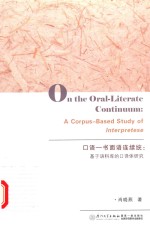
- 作 者:肖晓燕著
- 出 版 社:厦门:厦门大学出版社
- 出版年份:2015
- ISBN:9787561556184
- 标注页数:287 页
- PDF页数:304 页
请阅读订购服务说明与试读!
订购服务说明
1、本站所有的书默认都是PDF格式,该格式图书只能阅读和打印,不能再次编辑。
2、除分上下册或者多册的情况下,一般PDF页数一定要大于标注页数才建议下单购买。【本资源304 ≥287页】
图书下载及付费说明
1、所有的电子图书为PDF格式,支持电脑、手机、平板等各类电子设备阅读;可以任意拷贝文件到不同的阅读设备里进行阅读。
2、电子图书在提交订单后一般半小时内处理完成,最晚48小时内处理完成。(非工作日购买会延迟)
3、所有的电子图书都是原书直接扫描方式制作而成。
Chapter 1 Introduction 2
1.1 Research Background 2
1.1.1 The Primacy of Spoken Discourse 2
1.1.2 The Study of Translatese 4
1.1.3 Interpretese as Spoken and Translated Discourse 6
1.1.4 The Oral-Literate Continuum 8
1.2 Aims of the Study 9
1.3 Significance of the Study 11
1.4 Methodology and Data 14
1.4.1 Methodology 14
1.4.2 Data Selection 15
1.4.3 Data Preparation 18
1.4.4 Data Description 21
1.5 Structure of the Thesis 21
1.6 Terminology 23
Chapter 2 Literature Review 25
2.1 The Study of Language as Discourse 25
2.2 The Study of Spoken Discourse 29
2.2.1 Reawakening to the Primacy of Spoken Discourse 29
2.2.2 Spoken Discourse vs.Written Discourse 31
2.2.3 Orality vs.Literacy 35
2.3 Genre and Register 37
2.4 Corpus-Based Translation Studies 40
2.4.1 Impact of Corpus Linguistics 40
2.4.2 From“Equivalence”to“Norms” 41
2.4.3 Translatese and Translation Universals 42
2.4.4 The Study of Translatese in China 46
2.5 Corpus-Based Interpreting Studies 47
2.5.1 Challenges of Corpus-Based Interpreting Studies 48
2.5.2 Headways in Corpus-Based Interpreting Studies 49
2.5.3 Shlesinger's Work on Interpretese 51
2.5.4 Study on Interpretese in China 52
2.6 Evaluation of Previous Research 54
2.6.1 Inadequate Study of Interpretese as Spoken Discourse 54
2.6.2 Weakness in the Study of Interpretese as Translated Discourse 55
2.6.3 Issues with Chinese-English Interpreting Corpus 58
2.6.4 Methodological Issues of Studying Chinese-English Interpretese 59
Chapter 3 Theorectical Framework 60
3.1 G&RT as Conceptual Framework 60
3.1.1 Definition of Genre 60
3.1.2 Types and Functions of Genre 62
3.1.3 Differentiating Genre and Register 64
3.2 The MD Approach as Methodological Framework 66
3.2.1 The Dimensions 66
3.2.2 MD as a Macroscopic Approach 69
3.2.3 MD as a Microscopic Approach 70
3.2.4 MD as Quantitative and Qualitative Method 71
Chapter 4 Interpretese as a Genre 74
4.1 Defining Interpretese 74
4.1.1 Interpreting vs.Translating 75
4.1.2 I nterpretese Defined 79
4.1.3 Is Interpretese a Genre? 80
4.2 Describing Interpretese as a Genre 83
4.2.1 Modality 84
4.2.2 Ontology 85
4.2.3 Registers 86
4.3 Interpretese on the Oral-Literate Continuum 90
4.3.1 Zellermayer's Shifts on the Continuum 90
4.3.2 Shlesinger's Parameters of Orality 92
4.3.3 Biber's Dimensions of Orality 97
4.3.4 Measuring Orality:An Integrated Model 99
4.3.5 Modifying the Model for Chinese 111
Chapter 5 An MD Analysis of Interpretese 114
5.1 The Corpus 114
5.1.1 Strengths of the Current Corpus 114
5.1.2 Describing the Corpus 118
5.2 Selection of Linguistic Features 119
5.2.1 Dimension A:Involvedness 122
5.2.2 Dimension B:Constrainedness 126
5.2.3 Dimension C:Context-Boundedness 127
5.2.4 Dimension D:Abstractness 132
5.2.5 Dimension E:Prosody 133
5.3 Frequency Counts and Analysis 135
5.3.1 Dimension A 135
5.3.2 Dimension B 144
5.3.3 Dimension C 153
5.3.4 Dimension D 160
5.3.5 Dimension E 163
5.4 Gender as a Variable 169
5.4.1 Male Speakers vs.Female Speakers 169
5.4.2 Male Interpreters vs.Female Interpreters 171
5.5 Language Status as a Variable 174
5.5.1 English A Speakers vs.English B speakers 175
5.5.2 English A Interpreter vs.English B Interpreters 177
5.5.3 Chinese A Interpreters vs.Chinese B Interpreter 178
5.6 Factor Analysis 180
5.6.1 Why Factor Analysis? 180
5.6.2 Explaining Loadings 181
5.6.3 Identifying Factors 181
5.7 Interpreting the Data 186
Chapter 6 On the Oral-Literate Continum:Panel Discussions vs.Other Registers 186
6.1 Panel Discussion as a Register 188
6.2 Panel Discussions vs.Other Registers 190
6.2.1 Along the Continuum of Involvedness 191
6.2.2 Along the Continuum of Constrainedness 197
6.2.3 Along the Continuum of Context-Boundedness 200
6.2.4 Along the Continuum of Abstractness 204
6.2.5 A Multidimensional Description of Registers 205
Chapter 7 Conclusion 208
7.1 Findings from the Current Investigation 208
7.2 Significance and Implications 213
7.3 Limitations and Future Research 215
References 217
Appendices 242
Appendix 1 A sample of E-ST 242
Appendix 2 A sample of E-TT 250
Appendix 3 A sample of C-ST 262
Appendix 4 A sample of C-TT 266
Acknowledgements 287
